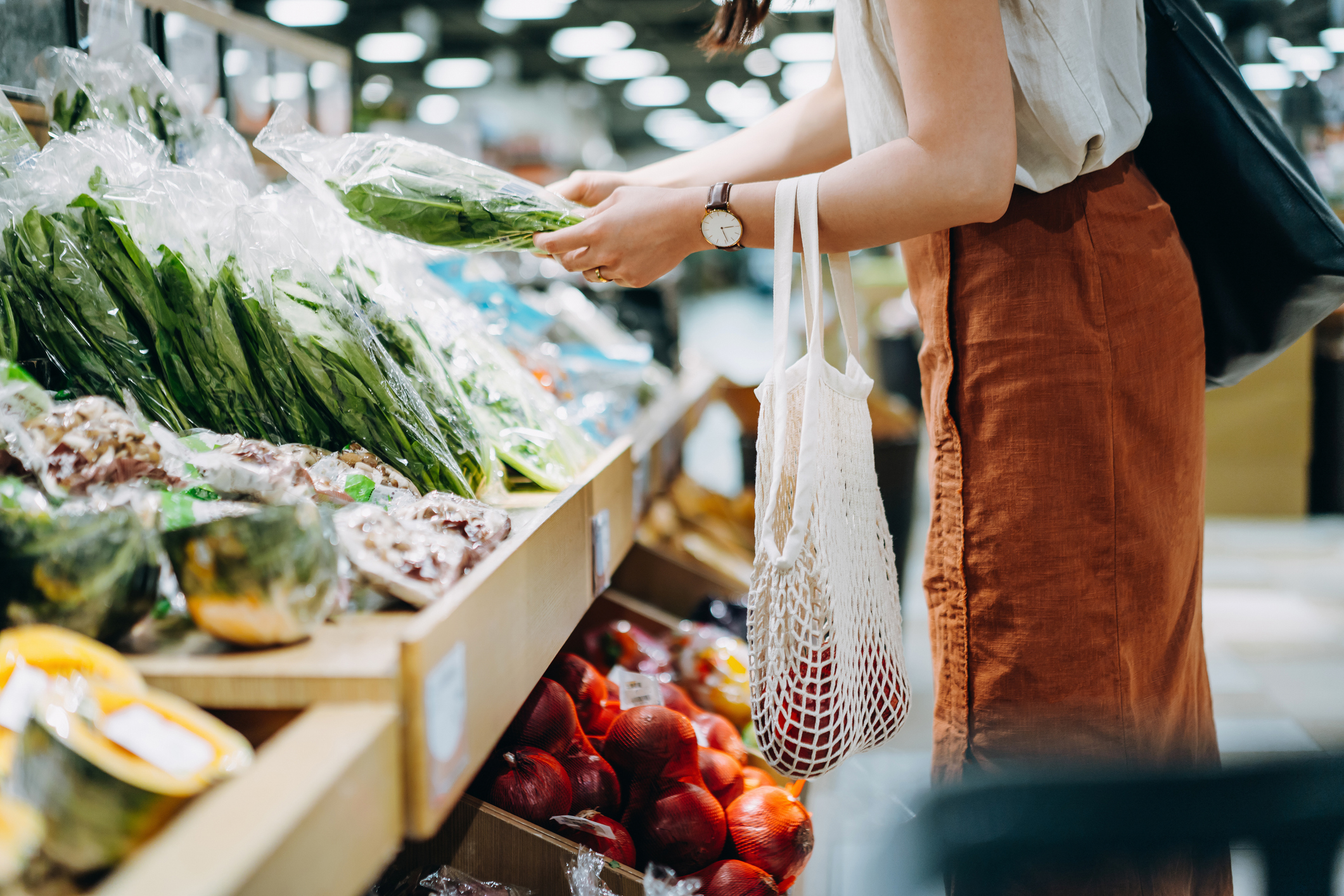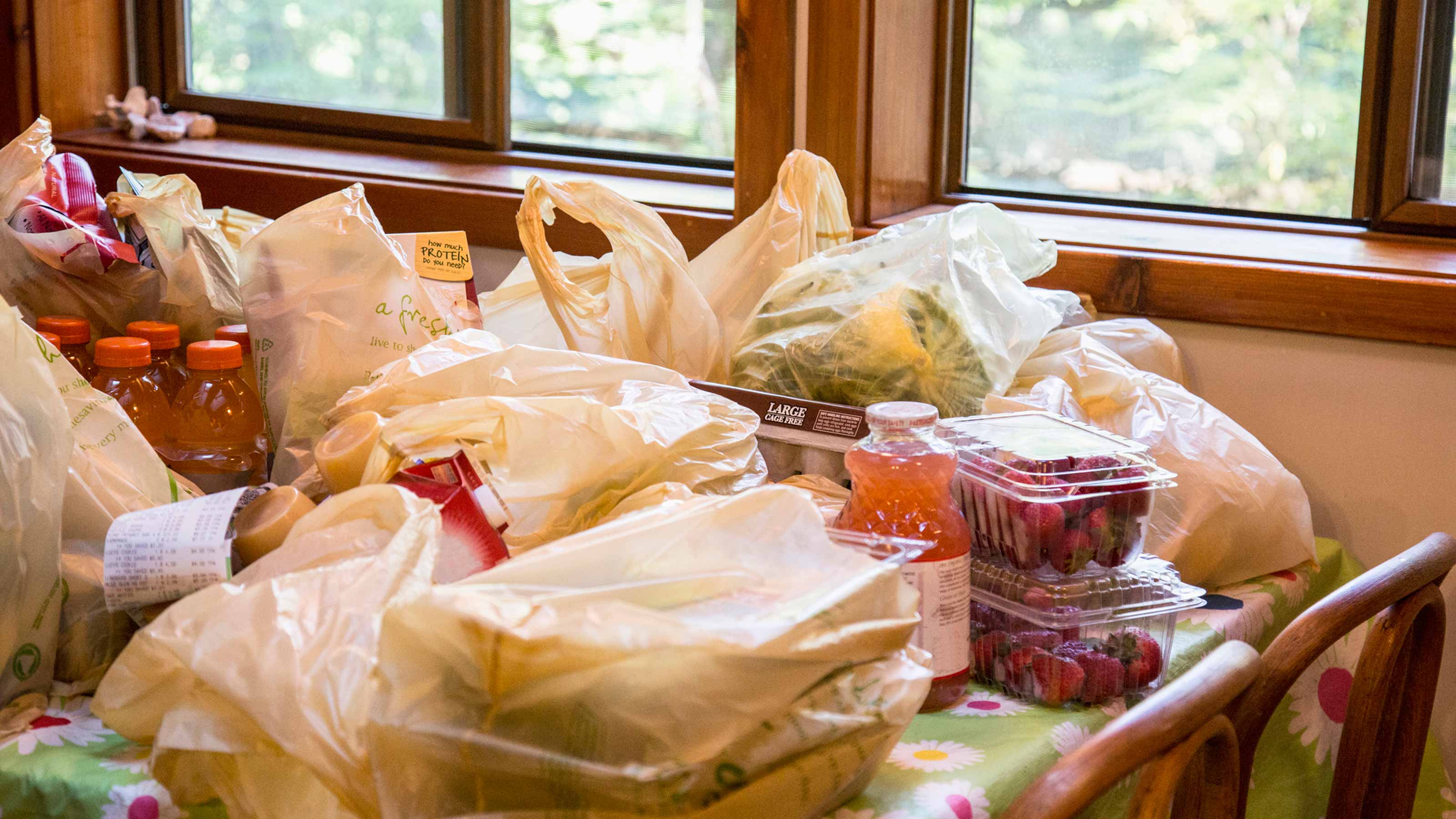18 Things You Should Know Before Shopping at Trader Joe’s
Everything you need to know to save money and shop smarter at the quirky Trader Joe’s supermarket chain.
Erin Bendig

The eclectic and retail-fan-favorite Trader Joe’s is well-known to its loyalists for its quirky culture and low prices on a unique selection of food items. The store doesn't carry many branded items, but it does offer a wide variety of interesting products (especially frozen ones) in the Trader Joe's label. Employees, easy to spot in their Hawaiian shirts, go out of their way to be helpful, and the stores are livened up by creative chalkboards and other decor (including plastic lobsters).
As usual, customers still appreciate the unconventional touches that help make the Trader Joe’s shopping experience stand out from a traditional grocer. They also appreciate how much they save when shopping at the grocery store chain, especially in today's inflated economy. One cost comparison from CNET pitted Trader Joe's and regional chain Stop & Shop and found that for a grocery list of around 50 items in various categories, Trader Joe's cost roughly 33% less.
If you’ve never been inside one of Trader Joe’s many locations but are eager to go, here are some shopping secrets to know before making your first trip.

1. Trader Joe’s has no plans to offer delivery or curbside pickup
Many big supermarket chains and big-box retailers that offer fresh grocery items have their own systems for online ordering for delivery or curbside pickup. However, Trader Joe’s says there aren’t any plans in the works to offer these services to its customers, as online ordering doesn't offer the same rewarding shopping experience provided by its brick-and-mortar stores.
Rather than cut staff to help fund services such as self-checkout, online ordering and delivery, the company instead prioritizes hiring on-site staff.
In an episode of its Inside Trader Joe’s podcast, Tara Miller, Trader Joe’s marketing director, said, “The bottom line here is that our people remain our most valued resource . . . our crew will be in our stores to help you find your next favorite product, just as they've always been.”
At other grocery stores, it's not uncommon to see aisle-hogging employees focused on getting those online orders pulled from the shelves and bagged, leaving them with no time to interact with customers who showed up to shop for themselves.

2. There's no self-checkout
Unlike many of its bigger counterparts, from Walmart to Kroger, Trader Joe’s has no plans to dip its toes into supermarket self-checkout registers, even though some of Trader Joe’s more rabid fans are screaming for it.
Why? Again, the focus remains on employees.
"We believe in people. We’re not trying to get rid of our crew members for efficiency’s sake,” the company’s president Jon Basalone stated in another episode of the aforementioned Inside Trader Joe’s podcast.

3. You can buy one banana for 23 cents
Buying produce in bulk can make financial sense as long as you’re sure you’ll use up everything before it goes bad or expires. That’s why some budget-conscious grocery shoppers avoid purchasing large quantities of fruits and vegetables, even though the price per unit might be cheaper.
A chance encounter, more than 25 years ago, between Trader Joe’s CEO and a customer at a Sun City, California, store confirmed this hesitation and led the grocer to start selling bananas individually. Like most grocers, Trader Joe’s used to sell bananas only by the pound. The smallest bag you could buy contained four or five bananas. One day while visiting the Sun City location, CEO Dan Bane observed an elderly customer examine a bag of bananas and then put it back on the shelf. When Bane asked why she didn’t buy the bag of bananas, he recalls the elderly shopper saying, “Sonny, I may not live to that fourth banana.”
The next day Trader Joe’s started selling single bananas for 19 cents apiece. The price wouldn't change for over two decades, until March of 2024, when inflation pushed the price up roughly 20% to 23 cents.
“We only change our prices when our costs change, and after holding our price for Bananas at 19¢ each for more than two decades, we’ve now reached a point where this change is necessary,” a Trader Joe's spokesperson said.
However, 23 cents per banana is still a good deal.

4. Aldi is part of the family
Trader Joe’s was founded in 1967 in Pasadena, California, by entrepreneur Joe Coulombe. It was acquired in 1979 by Aldi Nord, a German company that also operates Aldi grocery stores in Europe. Aldi Nord’s sister company, Aldi Sud, operates Aldi stores in the U.S.
Despite the corporate ties, the two chains have distinct marketing strategies. Aldi is price-driven and undercuts competitors by selling cheaper private-label versions of the most popular items at traditional supermarkets, retail experts note. Trader Joe’s also aims for affordability, but its driving force is a unique brand. It focuses on mostly prepackaged products in unusual flavor combinations that you won’t find anywhere else.

5. There are no sales or coupons at Trader Joe's
Most supermarket chains put select items on sale every week. But at Trader Joe’s, what you see is what you get when it comes to price. That means you won’t find any Trader Joe’s deals listed in your newsletters or voucher sites.
The grocer claims that because it already offers the lowest prices it can every day, there’s no room for sales, specials or coupons — and that bypassing all that marketing ultimately saves the customer as well.
To test this claim, we compared the price of a bottle of Trader Joe’s Organic Italian Dressing with a similar salad dressing available at Whole Foods. Here’s what we found: At Trader Joe’s you’ll pay $3.49 for a 12-ounce bottle, while you’ll pay $4.79 for a 12-ounce bottle of Whole Foods house brand 365 Organic Italian Romano Dressing at Whole Foods — a savings of $1.30 if you go with Joe.

6. Eight out of 10 items are store brands
In 1972, Trader Joe’s introduced its first private-label product: granola. Today, around 80% of the products carried by Trader Joe’s are the company's own brands, a company spokesperson told Kiplinger. The grocer says the heavy emphasis on store brands helps keep costs low because it buys directly from suppliers whenever possible (no middleman markup) and then passes the savings on to its customers.
It’s a common industry practice for traditional grocers to charge their suppliers fees for shelf placement, which results in higher prices for customers. Trader Joe’s says it doesn’t do it.
Health-conscious customers should know that the company claims all of its store-branded food and drinks are free of artificial flavors, artificial preservatives, synthetic colors and genetically modified (GMO) ingredients.

7. Want a Trader Joe’s near you? Just ask
If you’re now curious about visiting a Trader Joe's only to find out that there isn't a store near you, you have some recourse. Shoppers interested in bringing a store to their area should visit the Request a TJ’s in My City page on Trader Joe’s website and fill out the short questionnaire.
While Trader Joe’s can’t guarantee it will open a store in every requested city, if consumer demand is high enough in a particular area, management vows to give it serious consideration.

8. Trader Joe’s products come and go
It’s easy to get attached to your favorite snack (I’m lookin’ at you, TJ’s Cheddar Rocket Crackers). Just be warned that at Trader Joe’s your cherished item might not be around forever. There are even social media accounts dedicated to letting shoppers know when items are slated to be pulled from shelves or are strictly seasonal items (for example, check out @traderjoesgeek on Instagram).
Trader Joe’s rationale? Because store space is limited and new products are introduced every week, items that don’t catch on quickly need to make way. A product might also be pulled if the cost of producing it increases significantly.


10. Vegan, kosher and gluten-free options abound
If you have a food allergy or adhere to a strict diet, shopping at a traditional grocery store can be problematic. Oftentimes you’ll have to make multiple trips to several stores to grab everything on your list, which can be time-consuming. Trader Joe’s aims to make that weekly chore a bit easier for shoppers with special dietary needs by offering a vast selection of kosher, vegan and gluten-free items. All are clearly labeled. Special dietary offerings include organic brown rice and quinoa spaghetti, Miyoko’s vegan butter and gluten-free cinnamon raisin bread.
Shoppers can find a robust list of kosher, vegan and gluten-free products available at Trader Joe’s on the website, as well as related recipe ideas.

11. A ringing bell means help is on the way
Unlike most supermarkets that use intercoms to summon assistance, Trader Joe’s has a bell system. In keeping with its kitschy maritime theme (remember the plastic lobsters?), the grocer uses actual ship’s bells located near the checkout area to signal to employees that help is needed.
Here’s what all the noise is about: One ring lets employees know that another cash register needs to be opened. Two rings mean there are additional questions that need to be answered at the checkout area. Three rings signal that a manager is needed for further assistance. While this system may be a bit odd, shoppers seem to like the chain’s eccentricities. Trader Joe’s ranks fourth in customer satisfaction among supermarket shoppers, according to the most recent American Customer Satisfaction Index Retail and Consumer Shipping Report.

12. Stores donate unsold food to local charities
While offering customers quality products is a top priority for Trader Joe's, so is giving back to the community. The grocer says that it donates 100% of products that go unsold, but remain safe for consumption. Each store has a donation coordinator who is responsible for working with local food banks and soup kitchens to arrange daily donations. The company even donates non-food items such as fresh flowers and health and beauty products still in good condition.
Trader Joe's says that in 2023, it donated more than $469 million dollars of food and beverages to charities across the country.

13. All Trader Joe’s products go through a tasting panel
Trader Joe’s takes product quality seriously. Every product the grocer sells goes through a tasting panel and must receive a 70% vote of approval before it gets the green light to hit store shelves. If the panel doesn’t like it enough, you won’t see it at Trader Joe’s. There’s no “pay to play” for product placement, as is the case with most other supermarket chains.

14. Trader Joe’s offers budget blooms
You may not think of your local grocery store as the go-to spot for deals on fresh flowers but if you’re on a budget, Trader Joe’s should be on your radar, says consumer savings expert Andrea Woroch.
We did some comparisons of our own recently. Small potted orchids were selling for $14.99 at Trader Joe’s (while they’re usually around $16 at Walmart). If you’re in need of a reasonably priced bouquet in a pinch, Trader Joe’s flower section is usually located near the front of the store. A large seasonal bouquet is approx. $12.99.

15. Trader Joe’s says no to plastic packaging
When it comes to product packaging, Trader Joe’s is making a big push for sustainability. In 2019, the grocer began replacing the plastic and Styrofoam containers on items, including produce, meats and greeting cards, with renewable and plant-based alternatives.
For example, Trader Joe’s now uses a compostable tray instead of a Styrofoam version for its fruits and vegetables. Their product marketing team has also worked to replace the plastic sleeves on their greeting cards with a plant-based starch version to help keep them in pristine condition. The card sleeve is biodegradable, and shoppers can compost it at home.
The grocer announced in 2022 that it had removed more than 12 million pounds of plastic packaging from its products. This included getting rid of plastic bags — which the company started doing in 2018 — at the checkout register. You can get biodegradable paper bags or you can pay for one of their long-use Trader Joe's tote bags for heavier items.

16. Trader Joe’s gives you a heads-up on new products
One of the many quirks that keeps die-hard Trader Joe’s customers coming back is the unique food selection — from dark chocolate peanut butter cups to “Everything but the Bagel” sesame seasoning. While the grocer regularly releases new products, many customers only randomly stumble upon them. Luckily, there’s a way to find out about new products that hit store shelves sooner rather than later.
Shoppers can follow the What’s New page on the grocer’s website to learn about the most recent product launches. The page gets updated several times per week. Each post lists a new product’s ingredients and explains how it made its way onto store shelves and where you can find it in-store.
A few of the recent posts include Mango Sticky Rice Crisps, Ginger Shrimp Lo Mein and Crunchy Jicama Slaw. Shoppers can check this page and add desired items to their grocery lists before their routine weekend Trader Joe’s trip, which can help cut down on impulse shopping... although that's part of the pleasure of shopping at the store.


18. If you like wine you're in for a treat
While it may not have the widest selection of beers and soft drinks, Trader Joe's is famous for its wide selection of super-cheap and excellent value wines. Whether your tipple is a robust Californian Cabernet, a crisp Hungarian Gruner Veltliner or a bottle of French fizz, you'll find wine at every price point, starting at a rather alarming $2.99 and reaching the heady height of $30.
Profit and prosper with the best of Kiplinger's advice on investing, taxes, retirement, personal finance and much more. Delivered daily. Enter your email in the box and click Sign Me Up.

Bob was Senior Editor at Kiplinger.com for seven years and is now a contributor to the website. He has more than 40 years of experience in online, print and visual journalism. Bob has worked as an award-winning writer and editor in the Washington, D.C., market as well as at news organizations in New York, Michigan and California. Bob joined Kiplinger in 2016, bringing a wealth of expertise covering retail, entertainment, and money-saving trends and topics. He was one of the first journalists at a daily news organization to aggressively cover retail as a specialty and has been lauded in the retail industry for his expertise. Bob has also been an adjunct and associate professor of print, online and visual journalism at Syracuse University and Ithaca College. He has a master’s degree from Syracuse University’s S.I. Newhouse School of Public Communications and a bachelor’s degree in communications and theater from Hope College.
- Erin BendigPersonal Finance Writer
-
 10 Cheapest Places to Live in Washington
10 Cheapest Places to Live in WashingtonProperty Tax Is Washington your go-to ski destination? These counties combine no income tax with the lowest property tax bills in the state.
-
 Healthy to 100: Secrets from Countries Where Retirees Age Best
Healthy to 100: Secrets from Countries Where Retirees Age BestLongevity is a team sport, according to author Ken Stern. Here's the secret sauce for living long, healthy lives from countries like Italy and Japan.
-
 My First $1 Million: Semiretired CPA, 68, San Francisco
My First $1 Million: Semiretired CPA, 68, San FranciscoEver wonder how someone who's made a million dollars or more did it? Kiplinger's My First $1 Million series uncovers the answers.


